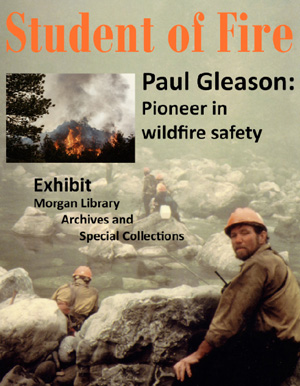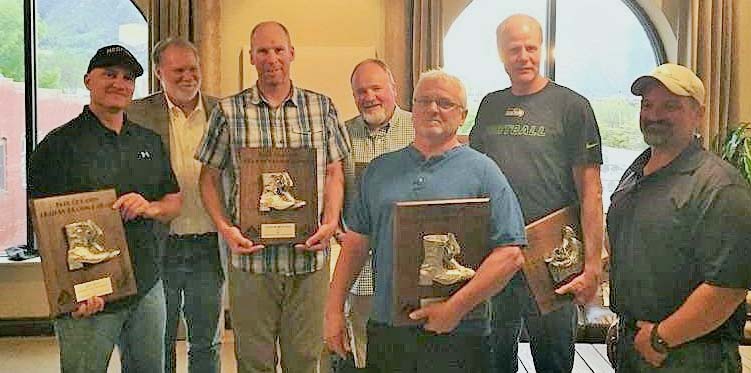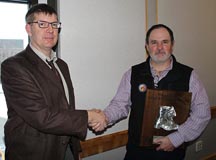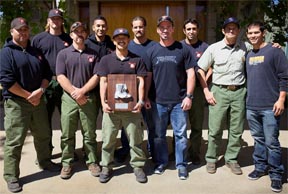Here’s a piece by Mike DeGrosky that recently ran in Wildfire Magazine, reprinted here with permission.
by MICHAEL DEGROSKY
A late-summer road trip with my wife in 2023 brought us near the Smith River, Happy Camp, and Hoopa complexes in Oregon and California. Along the way, we encountered Interagency Hotshot Crews (IHCs) traveling to, from, and around these fires. There are more than 100 IHCs in the United States – highly professional, mobile, and skilled hand crews assigned to the most challenging and high-priority fires. Though organization can vary, IHCs are typically led by a superintendent who is often referred to as The Supe.
As we passed the hotshots going about their business, I reflected on my long association with these crews. I was a hotshot for two fire seasons, one as a crew member and one as a squad boss. I consider those two seasons to be foundational for me as a fire professional, a leader, and as a person. When I worked as a division supervisor, I was always grateful when I was assigned hotshots; an all-career experience came when I was assigned six IHCs, punching hotline overnight, over steep and rugged terrain and through the ugliest snag patch I can recall.

Last year a friend gave me THE SUPE’S HANDBOOK: Leadership Lessons from America’s Hotshot Crews, by Angie Tom. I am quite proud that I know or knew more than 20 of the people profiled in Tom’s book – firefighting colleagues, training cadre teammates, audience members and training participants, and consulting clients. (Sadly, some are no longer with us.)
I was immediately drawn in by a balanced, honest, on-point foreword by Anthony Escobar, who was the superintendent of the Kern Valley IHC and retired as the FMO for the Los Padres in California. It is worth the price of the book just to read the foreword.
Brit Rosso was the superintendent of the Arrowhead Hotshots and later retired as manager of the Wildland Fire Lessons Learned Center. Included in this book are Rosso’s lessons learned from the line-of-duty death of crew member Dan Holmes. Anyone leading a fire program or an agency with a fire program should read Rosso’s account.
One night while reading this book, I cried; the author’s story of her trip to interview Paul Gleason, right at the time of his passing from cancer, brought a flood of memories. Gleason was superintendent of the Zigzag IHC on the Mt. Hood National Forest in Oregon long before retiring from the NPS; he was later an adjunct professor for the wildland fire science program at Colorado State University. Gleason’s contributions to the wildland fire service are legendary, including pioneering sawyer certification and the Lookouts, Communications, Escape routes, and Safety zones firefighter safety concept commonly known as LCES. Gleason made it cool for firefighters to be “students of fire.”
Jim Cook, who had introduced Gleason and Tom, went with her to the interview in Colorado. Cook was the superintendent of both the Arrowhead and Boise IHCs, retired as the training projects coordinator for the USFS, and served as principal architect of the NWCG leadership curriculum.
Tom’s story of her interview with Gleason reminded me that around the time of his death, I spent a powerful, emotional evening in a hotel ballroom in Santa Fe, New Mexico, with a group of his NPS colleagues, reminiscing and processing his passing. It proved an extra intense experience because it just so happened that we were also doing the first staff ride of the Cerro Grande Fire on which Gleason was the burn boss. Some of the people present had been principal players and most were already processing some strong emotions. All these years later, I find myself hoping the people who receive the NWCG Paul Gleason Lead By Example Award have a deep and intense understanding of the fire service leader in whose memory they are honored for their own achievements – and what that means.
I had three takeaways from The Supe’s Handbook. First, I was reminded of how some really intelligent people are drawn to fire. Note I did not say “educated” people. Some people profiled in the book have or had formal post-secondary education. Others are or were self-educated. Formal higher education is not prominent in the group of hotshot supes featured in this book. However, intelligence is.
Second, whether those included overtly acknowledged it or not, they were and are passionate students of leadership, for whom the responsibilities of leadership weighed heavily; they took their leadership very seriously. The fire part seemed to come easily; their focus was on leading their people.
Third, I was reminded of how often I have seen this kind of intelligence and leadership savvy go under-recognized, under-utilized, or even dismissed – because people could not see past the big, sometimes rough and blunt personalities, educational credentials, or their own insecurities.
As a lifelong fire professional, including 20 years as a consultant to wildland fire agencies, I’ve encountered more than one senior leader who would have benefitted from some coaching and mentoring from people in this book.

Mike DeGrosky is a student of leadership, a lifelong learner, mentor and coach, sometimes writer, and recovering fire chief. He taught for the Department of Leadership Studies at Fort Hays State University for 10 years. Follow Mike on LinkedIn.






